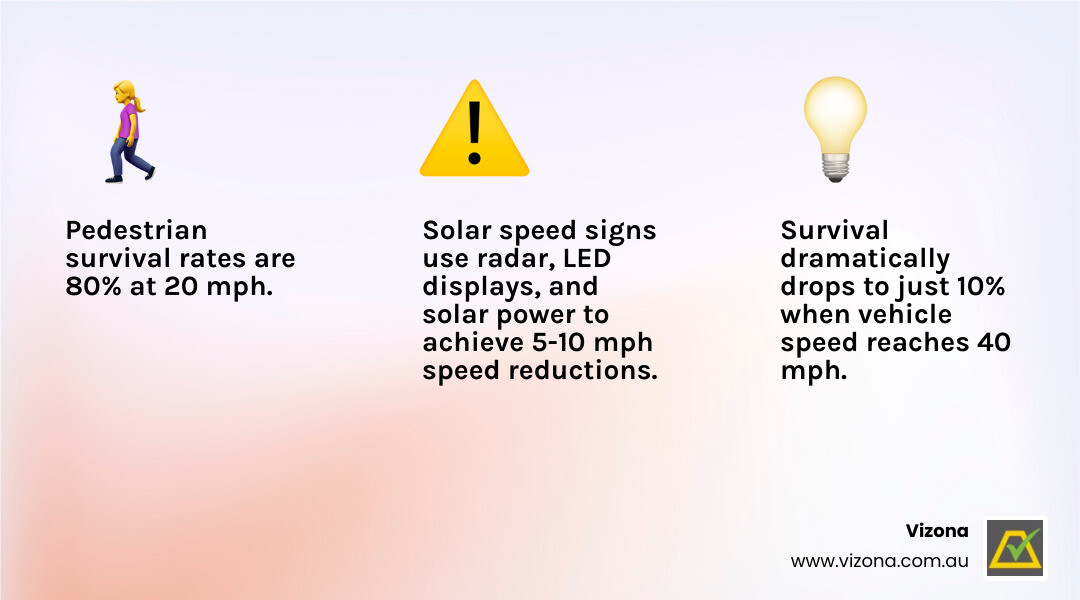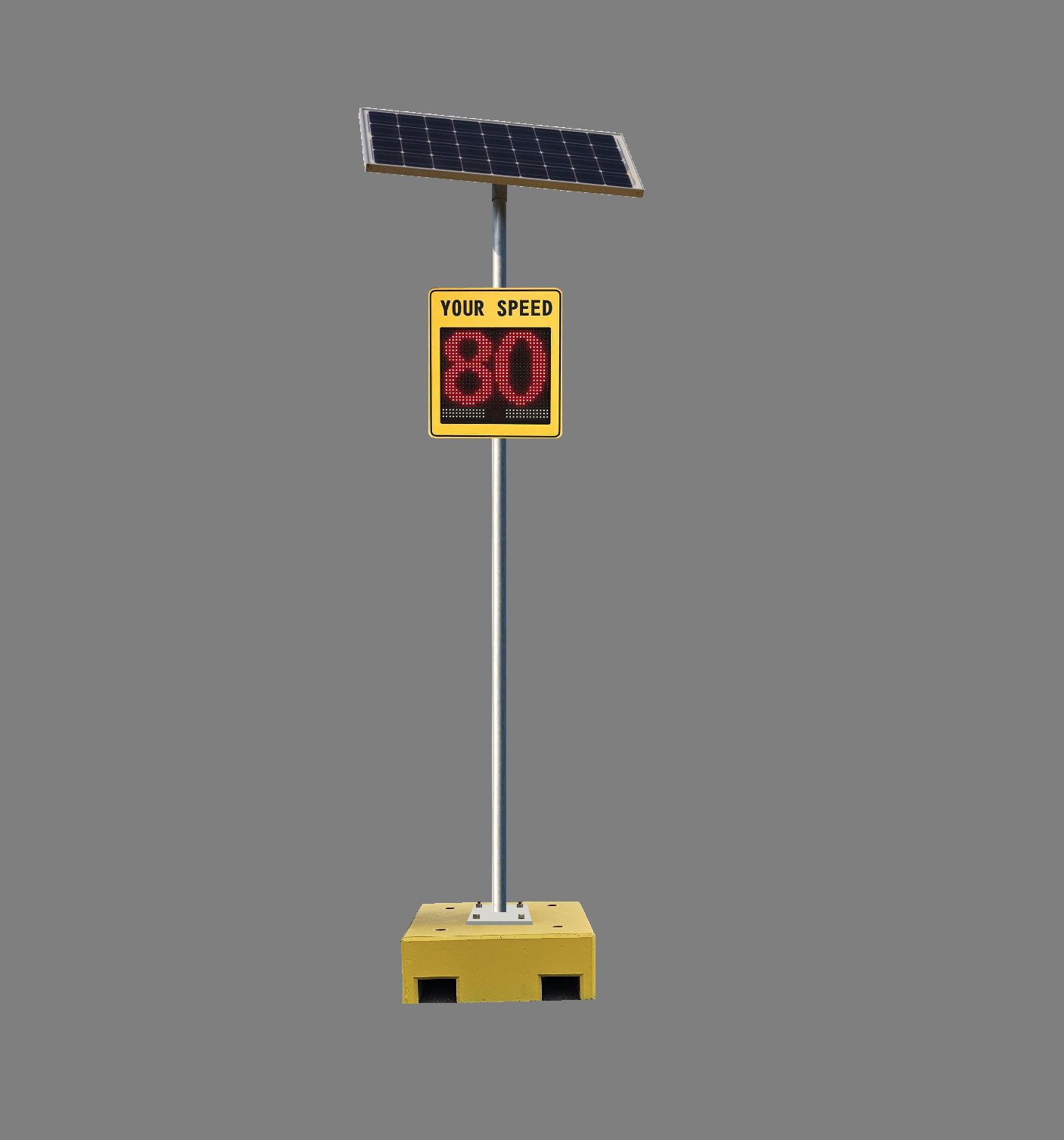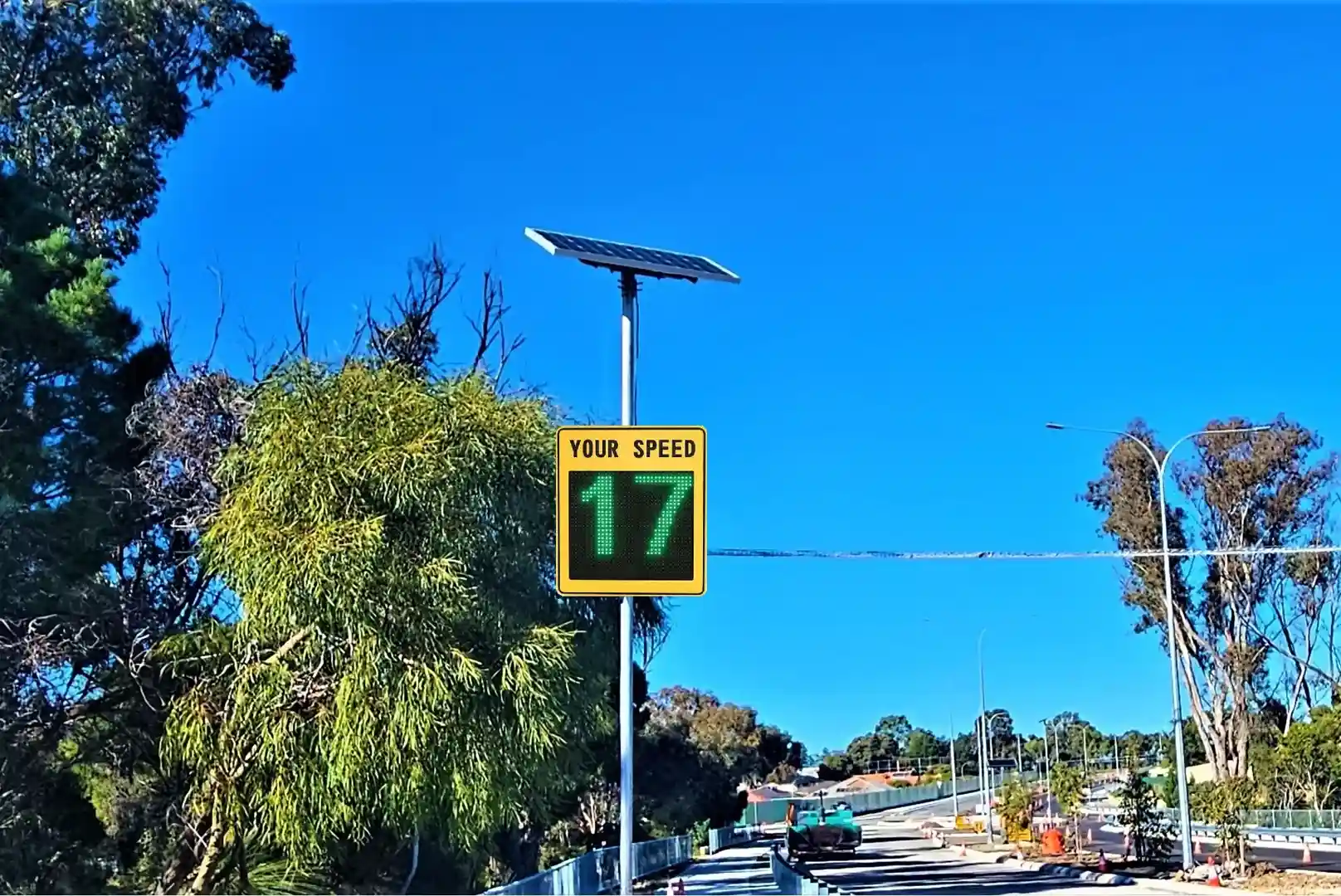Why Solar Speed Signs Are a Smart Choice for Modern Road Safety
Solar speed signs are revolutionizing traffic management, offering an effective, sustainable solution to reduce vehicle speeds and improve road safety across Australia.
Quick Guide: Solar Speed Signs at a Glance
- Technology: Doppler radar + LED display + solar power system
- Speed Reduction: 5-10 mph average reduction (up to 9 mph in school zones)
- Safety Impact: 1 mph reduction = 5% fewer injuries
- Power Source: Self-sufficient solar operation with battery backup
- Applications: School zones, construction sites, residential streets
- Benefits: Zero running costs, low maintenance, immediate deployment
- Data Collection: Traffic monitoring and compliance reporting available
These intelligent traffic devices use radar technology to detect approaching vehicles and display their current speed on a bright LED screen. This real-time feedback encourages drivers to slow down; studies show radar signs reduce average speeds by 5-10 mph.
The safety implications are profound. Research demonstrates that reducing speeds by just 1 mph decreases injury risk by 5%. Considering pedestrian survival rates drop from 80% at 20 mph to just 10% at 40 mph, the need for effective speed management is clear.
Solar-powered models eliminate electrical connections and ongoing energy costs, making them ideal for remote locations, temporary installations, and councils pursuing sustainable infrastructure goals.
At Vizona, we have helped Australian councils deploy hundreds of solar speed sign solutions across diverse applications, from remote construction sites to busy school zones. Our experience with major infrastructure projects like Snowy Hydro 2.0 demonstrates how effective these systems are at improving road safety while reducing operational costs.

A Deep Dive into the Benefits and Technology of a Solar Speed Sign
Solar speed signs represent a shift toward smarter, more sustainable traffic management. Their effectiveness lies in providing immediate, non-confrontational feedback that encourages drivers to self-correct their speed.
How Do Solar Speed Signs Actually Work?
Every solar speed sign integrates three core systems: a solar power unit, a radar detector, and an LED display. This self-sufficient design harnesses solar energy, measures vehicle speed, and communicates instantly with drivers.
The Solar Power System
A solar panel converts sunlight into electricity, which charges a deep-cycle battery. This stored energy powers the sign continuously, day and night, even through cloudy periods. Vizona systems are engineered for Australian conditions, with battery backups providing several days of autonomous operation to ensure constant reliability.
Doppler Radar Detection
The sign uses Doppler radar to measure speed. A radar unit emits low-power radio waves that bounce off approaching vehicles. The system calculates the vehicle's speed based on the change in the frequency of the returning waves, providing an instant and accurate reading.
LED Display Communication
The calculated speed is shown on a high-intensity LED display, which is visible in bright sunlight and auto-dims at night. Signs can also be programmed with messages like "SLOW DOWN" for speeding drivers or "THANK YOU" for those complying with the speed limit.
For more insights into solar power technology and battery management systems, you can explore our Cality Solar Batten Light which uses similar photovoltaic principles.
The Top Benefits of Using a Solar Speed Sign
The impact of solar speed signs extends far beyond simple speed reduction.
Immediate Speed Reduction
These signs are proven to reduce average speeds by 5-10 mph, with some school zones seeing reductions of up to 9 mph within the first week. The direct, non-confrontational feedback is more effective than static signs, creating immediate driver awareness.
Improved Driver Awareness
Solar speed signs cut through distractions by providing a clear reality check. Seeing their actual speed displayed makes drivers instantly aware of their behaviour, and this heightened consciousness often continues throughout their journey.
Dramatic Safety Improvements
Lower speeds save lives. A 1 mph speed reduction can decrease injury risk by 5%. For vulnerable pedestrians, this is critical, as survival rates drop from 80% at 20 mph to just 10% at 40 mph. The signs create calmer, safer traffic environments for the entire community.
Zero Ongoing Energy Costs
Operating entirely on renewable energy, these signs have no electricity bills or grid connection costs, offering significant long-term savings for councils. The durable solar panels require only occasional cleaning to maintain efficiency.
Environmental Leadership
By eliminating grid electricity use and promoting smoother traffic flow, these signs support sustainability goals. Their aluminium construction is also highly recyclable, contributing to a circular economy.
Low Maintenance Operation
Built for harsh Australian conditions, quality signs are weather and vandal-resistant. They require minimal maintenance, usually just periodic cleaning and battery checks every few years.
Valuable Data Collection
Many signs collect valuable traffic data, such as vehicle counts, speeds, and peak traffic times. This information helps traffic engineers make evidence-based decisions and allows police to target enforcement efforts more effectively.
Scientific research from institutions like the Texas A&M Transportation Institute provides compelling evidence of radar sign effectiveness across diverse applications.
Key Features to Consider Before You Buy
Selecting the right solar speed sign requires matching technology to your specific needs.
Display Visibility Requirements
Digit height (e.g., 12", 15", 18") should match the road type. Smaller digits suit low-speed residential streets, while larger displays are needed for high-speed roads where visibility from a distance is crucial. Premium LED brightness ensures visibility in all conditions.
Radar Performance Specifications
Detection range should provide drivers with enough time to react. Some systems offer bidirectional detection, monitoring traffic from both directions with a single unit.
Data Collection and Connectivity
Data logging and cloud connectivity allow for remote monitoring, automated reporting, and configuration changes without site visits.
Construction and Durability
Look for marine-grade aluminium housings and high IP ratings (IP65 or higher) to ensure resistance to weather and dust. Vandal resistance is also crucial for public installations.
Power System Sizing
Ensure the solar panel wattage and battery capacity are sufficient for your location's climate to guarantee reliable, year-round operation.
Common Mistakes to Avoid When Choosing Your Sign
Smart purchasing decisions avoid these common pitfalls.
Underestimating Location Requirements
A busy arterial road requires different specifications (e.g., larger display, longer radar range) than a quiet residential street. Assess traffic volume, speeds, and conditions.
Inadequate Power System Design
Choosing a system with insufficient solar or battery capacity will lead to unreliable performance. Always specify a system with multi-day autonomy suited to local weather patterns.
Overlooking Data Capabilities
Signs without data logging miss opportunities for traffic analysis. Data provides crucial insights for measuring ROI and planning future safety improvements.
Poor Durability Specifications
Cheaper signs not built for Australian conditions can fail prematurely. Invest in systems with high weather resistance (IP rating) and vandal-resistant construction.
Inadequate Placement Planning
Signs need clear sight lines and sufficient reaction distance, away from intersections or curves that could distract drivers.
Ignoring Compliance Standards
Ensure your chosen system complies with all relevant Australian Standards and local council requirements to avoid legal and operational issues.
Featured Solution: The Vizona RoadSmart Plus Speed Radar Sign
When it comes to proven solar speed sign technology, our RoadSmart Plus stands out as a comprehensive solution designed specifically for Australian conditions. It combines reliability, sustainability, and a genuine traffic-calming impact.

RoadSmart Plus: Specifications and Advantages
- Real-Time Feedback – A bright LED screen provides instant, personal speed feedback, prompting an estimated 80 % of drivers to slow down without punitive measures.
- Self-Powered & Flexible – Robust solar panel and battery storage ensure continuous, off-grid operation for easy deployment in busy urban corridors and temporary roadworks.
- Sustainable & Low Maintenance – Runs on clean solar energy and uses marine-grade aluminium for long-term durability, cutting carbon emissions and service visits.
- Improved Safety – By calming traffic, the RoadSmart Plus protects vulnerable road users—pedestrians, cyclists, and road workers—making streetscapes more liveable.
Ideal Urban Applications
- School zones & childcare centres – Reinforce lower limits during drop-off and pick-up.
- Inner-city construction sites – Protect crews and manage traffic diversions.
- High-density residential streets – Reduce through-traffic speeds and noise.
- Active transport corridors – Safeguard pedestrians and cyclists on shared paths.
- Special events & pop-up precincts – Deploy quickly where crowds gather.
Ready to Create Safer Urban Streetscapes?
Our team can tailor a RoadSmart Plus package to suit your location, data needs, and compliance requirements.
Contact Vizona today:
• Phone: 1300 250 150
• Email: info@vizona.com.au
Whether you’re managing a major infrastructure project or refining safety in your local community, the RoadSmart Plus delivers measurable results—fast.

